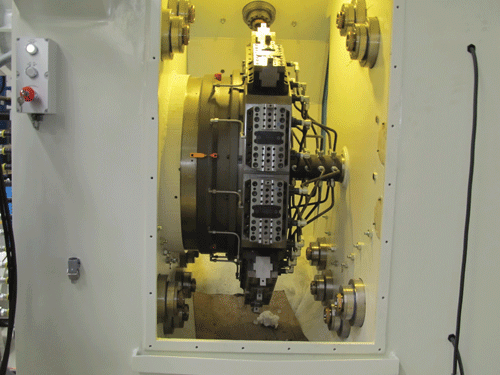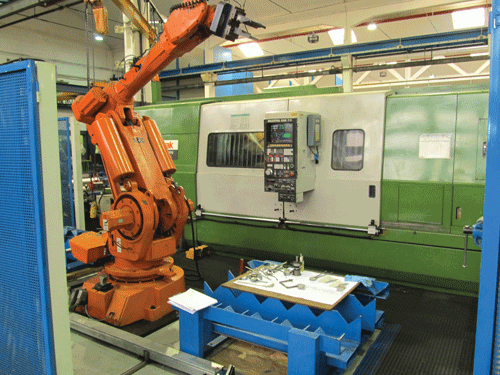Road Trip to Gnutti Transfer
With Production Machining’s focus on the markets Gnutti is looking at, it was logical for me to go and see what this company was about. So off I went.
Even by my lax standards, it was a quick trip. I hop a plane on Sunday evening last October and arrive at Malpensa in Milan, Italy, on a Monday morning. Tuesday was spent visiting machine tool builder Gnutti Transfer in Ospitaletto, which lies between Milan and Venice near Brescia in Northern Italy. Then, I flew back to the States early Wednesday. The term “whirlwind” doesn’t give it justice.
With Production Machining’s focus on the markets Gnutti is looking at, it was logical for me to go and see what this company was about. So off I went. My visit to Gnutti originated at IMTS with a discussion at the company’s booth where I met Bill Eigenbrode, sales and marketing manager for GNA (Gnutti North America). That meeting was set up by Bill Nuetzel, who helps the company penetrate the small to medium job shop market in North America.
Since 1955, this third generation builder has supplied horizontal and vertical rotary transfer machinery to markets around the world. Four years ago, the company made the strategic decision to open a direct office in the North American manufacturing market. Previously, it used distributors to represent the company’s line of machine tools. The office, known as GNA, was set up in Palatine, Ill., to service the installed base of machines and pursue new machine sales.
Mr. Eigenbrode and Mr. Nuetzel told me that Gnutti has been successful with installations in large OEM and contract shops through the years, but that part of the strategic move into North America includes reaching a broader swath of metalworking shops. As our cost of manufacturing continues to be more globally competitive, for many reasons, North America is increasingly attractive for sophisticated machine tool manufacturers. Gnutti considers itself to be one of these players and is planning to become better known in this market.
On the Shop Floor
The company’s headquarters and main manufacturing plant in Ospitaletto, where I spent most of my trip, has grown considerably since its founding almost 60 years ago. Today, the complex is 70,000 square meters and currently employs 160 workers, with more being added.
According to the company, Gnutti has a global installed base of more than 2,800 transfer machines. In general, these machines are found in high volume production shops serving the sanitary fitting, valve, lock, hydraulic brake cylinder, fitting and automotive part as well as petrochemical industries.
Like most machine tool plants I’ve visited, the Gnutti facility is integrated vertically with design, production and assembly carried out within the company’s headquarters. These are not commodity machine tools, and the engineering required is task based to solve specific production needs in the key industries served.
Design and engineering use 3D CAD modeling in concert with sophisticated finite element analysis to test the design and engineering solutions in preproduction. Then these designs are sent to the production floor for manufacturing. A key to the company’s success is implementation of modularity in its base models of horizontal and vertical transfer machines allowing for upgrades through the significant life of the machine.
As we walked through the assembly and run-off bay, numerous machines in various stages of completion were visible. All of these machines were sold, indicating that business for Gnutti is good despite reports to the contrary coming from the European market.
All of the mechanical parts used in the company’s machine tools are machined in-house. It’s a capability that has been built on more than 50 years of manufacturing, and the investment continues. It’s said that the machine tool industry is often its own best customer, and Gnutti reflects this in its stable of machining capacity. Brands such as Pama, Dixi and Heller are among the numerous machines used to manufacture the mechanical parts that comprise the company’s transfer machines.
Although every machine in the build stage is considered a custom, in that various options are added or deleted to the base machines for specific application requirements, there is an efficient flow of materials through the shop. During the different assembly operations, fine tuning for finish, fit and function are carried out by the assembly technicians.
Extensive Line
The transfer machines made by Gnutti are either vertical axis or horizontal axis in their configuration—the horizontal axis employs the trunnion-style turret while the vertical axis uses a horizontal turret. Both configurations are designed to machine parts from barstock, castings, forgings or blanks using progressive multi-axis machining stations.
All of the machines are under full CNC and controls are specified by the customer. For the North American market, Fanuc CNC is being offered.
For most turning applications, off-the-shelf indexible inserts are used for simplified change-over and reduced tooling costs. Stationary barstock is secured in quick-change chuck jaws that use sets of master jaws. Part specific jaws are mounted on the masters to expedite change-over.
For castings and forgings, various material handing devices can be employed to load and unload
the machine tools. Robots are a popular choice, but walking beams and other mechanisms have been successfully applied.
Machines have been designed and built with four to 14 workstations. Multi-axis spindles are brought to bear on the workpieces and provide complete six-sided machining operations, eliminating any need for secondary work.
Gnutti transfer machines have been successfully applied in numerous high volume production industries cutting brass, bronze, aluminum and steel. In one application, the company designed a transfer machine for producing couplings and straight fittings in brass. Production volumes for this application are quoted at as many as 1,600 pieces an hour.
While it might not be practical to visit Italy, if there is a rotary transfer application in your shop, perhaps a virtual visit to this builder via its website might be in your best interest.
Related Content
Independent Turning Cell Enables High Concentricity Precision
PMTS 2023: The RV 10 Flexmaster rotary transfer machine’s precision turning cell (PTC) is integrated in the machine as a disconnected turning cell and is free of the drive and machining factors that affect the other stations.
Read MoreCNC Rotary Transfer Machine Offers AI-Learning, Chipbreaking
Hydromat’s Force CNC Rotary Transfer Machine comes equipped with Force 50/150 tool spindle units, which are FANUC-controlled and offer advanced technology for AI-learning and chipbreaking functions.
Read MoreEdge Technologies Bar Feeder Provides Optimal Stock Support
The FMB Turbo RS 4-45 bar feeder provides reduced vibration, a boost to maximum rpm, better surface finishes and the ability to hold tighter tolerances.
Read MoreEdge Technologies Bar Feeder Maximizes RPM Potential
The second-generation Patriot 338 and 551 were designed for faster changeovers, ease of use and safe operation.
Read MoreRead Next
Emerging Leaders Nominations Now Open
Here’s your chance to highlight a young person in your manufacturing business who is on the path to be a future leader moving your company forward.
Read More5 Aspects of PMTS I Appreciate
The three-day edition of the 2025 Precision Machining Technology Show kicks off at the start of April. I’ll be there, and here are some reasons why.
Read MoreDo You Have Single Points of Failure?
Plans need to be in place before a catastrophic event occurs.
Read More














.jpg;maxWidth=300;quality=90)












